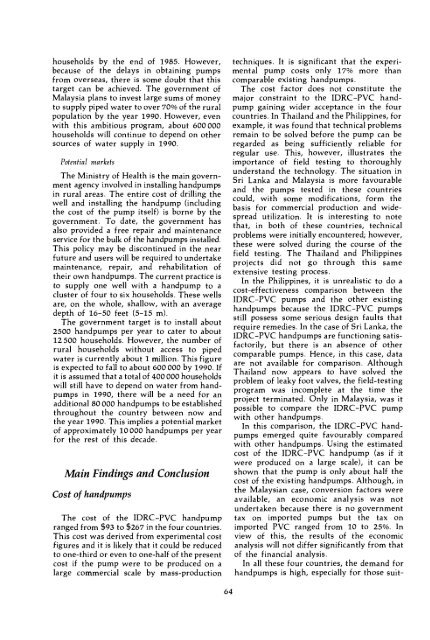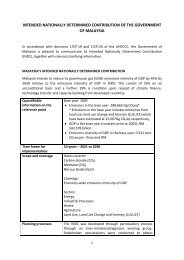RP-01638
RP-01638
RP-01638
You also want an ePaper? Increase the reach of your titles
YUMPU automatically turns print PDFs into web optimized ePapers that Google loves.
households by the end of 1985. However,<br />
because of the delays in obtaining pumps<br />
from overseas, there is some doubt that this<br />
target can be achieved. The government of<br />
Malaysia plans to invest large sums of money<br />
to supply piped water to over 70% of the rural<br />
population by the year 1990. However, even<br />
with this ambitious program, about 600 000<br />
households will continue to depend on other<br />
sources of water supply in 1990.<br />
Potential markets<br />
The Ministry of Health is the main government<br />
agency involved in installing handpumps<br />
in rural areas. The entire cost of drilling the<br />
well and installing the handpump (including<br />
the cost of the pump itself) is borne by the<br />
government. To date, the government has<br />
also provided a free repair and maintenance<br />
service for the bulk of the handpumps installed.<br />
This policy may be discontinued in the near<br />
future and users will be required to undertake<br />
maintenance, repair, and rehabilitation of<br />
their own handpumps. The current practice is<br />
to supply one well with a handpump to a<br />
cluster of four to six households. These wells<br />
are, on the whole, shallow, with an average<br />
depth of 16-50 feet (5-15 m).<br />
The government target is to install about<br />
2500 handpumps per year to cater to about<br />
12 500 households. However, the number of<br />
rural households without access to piped<br />
water is currently about 1 million. This figure<br />
is expected to fall to about 600 000 by 1990. If<br />
it is assumed that a total of 400 000 households<br />
will still have to depend on water from handpumps<br />
in 1990, there will be a need for an<br />
additional 80 000 handpumps to be established<br />
throughout the country between now and<br />
the year 1990. This implies a potential market<br />
of approximately 10 000 handpumps per year<br />
for the rest of this decade.<br />
Main Findings and Conclusion<br />
Cost of handpumps<br />
The cost of the IDRC-PVC handpump<br />
ranged from $93 to $267 in the four countries.<br />
This cost was derived from experimental cost<br />
figures and it is likely that it could be reduced<br />
to one-third or even to one-half of the present<br />
cost if the pump were to be produced on a<br />
large commercial scale by mass-production<br />
techniques. It is significant that the experimental<br />
pump costs only 17% more than<br />
comparable existing handpumps.<br />
The cost factor does not constitute the<br />
major constraint to the IDRC-PVC handpump<br />
gaining wider acceptance in the four<br />
countries. In Thailand and the Philippines, for<br />
example, it was found that technical problems<br />
remain to be solved before the pump can be<br />
regarded as being sufficiently reliable for<br />
regular use. This, however, illustrates the<br />
importance of field testing to thoroughly<br />
understand the technology. The situation in<br />
Sri Lanka and Malaysia is more favourable<br />
and the pumps tested in these countries<br />
could, with some modifications, form the<br />
basis for commercial production and widespread<br />
utilization. It is interesting to note<br />
that, in both of these countries, technical<br />
problems were initially encountered; however,<br />
these were solved during the course of the<br />
field testing. The Thailand and Philippines<br />
projects did not go through this same<br />
extensive testing process.<br />
In the Philippines, it is unrealistic to do a<br />
cost-effectiveness comparison between the<br />
IDRC-PVC pumps and the other existing<br />
handpumps because the IDRC-PVC pumps<br />
still possess some serious design faults that<br />
require remedies. In the case of Sri Lanka, the<br />
IDRC-PVC handpumps are functioning satisfactorily,<br />
but there is an absence of other<br />
comparable pumps. Hence, in this case, data<br />
are not available for comparison. Although<br />
Thailand now appears to have solved the<br />
problem of leaky foot valves, the field-testing<br />
program was incomplete at the time the<br />
project terminated. Only in Malaysia, was it<br />
possible to compare the IDRC-PVC pump<br />
with other handpumps.<br />
In this comparison, the IDRC-PVC handpumps<br />
emerged quite favourably compared<br />
with other handpumps. Using the estimated<br />
cost of the IDRC-PVC handpump (as if it<br />
were produced on a large scale), it can be<br />
shown that the pump is only about half the<br />
cost of the existing handpumps. Although, in<br />
the Malaysian case, conversion factors were<br />
available, an economic analysis was not<br />
undertaken because there is no government<br />
tax on imported pumps but the tax on<br />
imported PVC ranged from 10 to 25%. In<br />
view of this, the results of the economic<br />
analysis will not differ significantly from that<br />
of the financial analysis.<br />
In all these four countries, the demand for<br />
handpumps is high, especially for those suit-<br />
64



